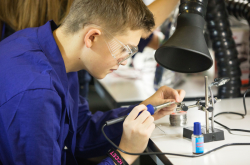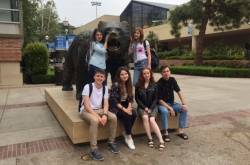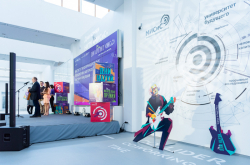The annual contest is organized by St. Petersburg Committee for Science and Higher Education. Its goal is to increase the quality of specialists' training, to facilitate the competitive ability of graduates of St. Petersburg universities, and to contribute to solving relevant tasks of the city's social and economic development.
Both Bachelor's and Master's students can participate in the contest. Traditionally, there are several requirements that the candidates have to comply with: the topic of their thesis project has to correspond to their educational organization's profile, and the project's authors have to be in good academic standing.
The applications for participation are sent to the Committee for Science and Higher Education; this year, the contest committee chose 90 of the applicants' projects. Authors of the best of them presented their works in an exhibition that took place at Saint Petersburg State University of Economics. The contest committee led by Vice-Governor Vladimir Kirillov attended the presentations.

"At the contest, we look at the different projects that can be introduced in our city. And I have to note that the government pays a lot of attention to those. Student communities give us a fresh perspective which helps us to analyze the existing problems. Here at the exhibition, we have about 80 projects developed on the order of different committees - solutions in the field of transport, education, and much more. Authors of the best works will be rewarded; what is more, in the future they'll be sought-after by governmental bodies and municipal entities," comments Vladimir Kirillov.
Five projects by ITMO University students were presented at the exhibition. Ekaterina Ilyina, Master's student at the Institute of Design & Urban Studies, developed a methodology for assessing the sufficiency of schools in St. Petersburg. The method is based on two key criteria of assessment - spatial, i.e. the school's pedestrian accessibility, and quantitative, i.e. the schools’ ability to accept the necessary amount of students.

For calculating the spatial criteria, the project's author proposed such methods as drawing coverage areas and computing the minimal distance by using a graph of the pedestrian network. She also developed a set of assessment methods that implies modeling a process when all the schools are simultaneously assigned children from the nearby houses. As a result, Ekaterina developed an algorithm for assessing the sufficiency of schools and created a program that can help define the districts that need more schools, and those that already have enough of them.
"The project's goal is to develop a program that will help assess the sufficiency of schools in regard to the number of residential houses, and find out where the situation is most severe. The project accounts for two requirements: first of all, the pedestrian accessibility (500 meters in our case), and secondly, the schools' capability to accept the necessary amount of students. Naturally, I am highly interested in the further development of the project; I also hope that it will be used on the governmental level, by various committees, so that they will have an objective assessment of the current situation," shares the Master's student.
The project has already been tested in the city's Vasilyevsky district. According to Ekaterina, the methodology is cross-functional, and can be used to assess both virtual and anticipated sufficiency of almost any facilities.

Anna Pomogaeva from the Faculty of Technological Management and Innovations presented a project on developing a new fare system for St. Petersburg. The project was ordered by St. Petersburg's Committee for Transport, and made use of both the Committee's data and best international practices.
"The project's goal is to transfer the fare system to a cashless settlement, as well as to develop a system that won't require conductors. In my work, I analyze the methods that will help to reduce the number of different travel ticket types. As of now, 36 different types of tickets are being used in St. Petersburg. The project aims to make it so that there will be 3-4 of them. All of that will make it possible to unite land transport and the subway into a common system," comments the project's author.

For one, Anna proposes to start the transition to a conductor-less fare system by making conductors work on several routes at once. This way, they will be checking each route only several times a day. Another aspect of the project is the introduction of a new system of fines. What is more, Anna discusses the feasibility and the possible effect of fixing public transport stops with self-service terminals, as well as switching to time-based billing.
Natalya Chalaya, another student of the Faculty of Technological Management and Innovations, developed a project for the Committee for Industrial Policy and Innovations. On the example of St. Petersburg Technopark OJSC, she defined the criteria for assessing the efficiency of providing targeted subsidies for innovation activities, as well as proposed a method for assessing the indirect cost impact.
Among the works presented by ITMO students were Alina Bebyakina's project on using information analysis technologies for monitoring St. Petersburg's consumer market, and Maria Pilishkina's assessment of prospects of the EAU market for the city's export-oriented enterprises.





